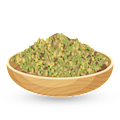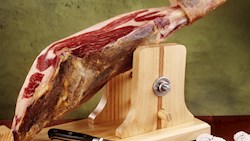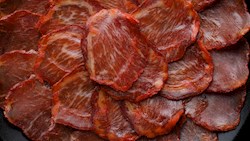Italy’s most emblematic culinary creation, the genuine pizza Napoletana is made with just a few simple ingredients and prepared in only two variations – marinara, the basic Neapolitan pizza topped with a tomato-based sauce flavored with garlic and oregano, and margherita, which is topped with tomatoes, mozzarella, and fresh basil leaves, a delicious combination whose colors are said to represent the Italian flag.
The crust is very thin at the base, and the dough puffs up on the sides, which results in airy crust that should have typical charred 'leopard spots' if baked properly. The origins of this iconic Neapolitan dish can be traced to the early 1700s, when what we know today as pizza marinara was first described by Italian chef, writer, and philosopher Vincenzo Corrado in his treatise on the eating habits of the people of Naples.
OTHER VARIATIONS OF Pizza
MOST ICONIC Pizza Napoletana
View moreThis variety of Iberian ham is produced with meat coming from acorn-fed Iberian pigs that are either 75% or 50% pure Iberian breed, meaning they have been crossbred with other pigs such as the Duroc breed. As in the case of jamón 100% ibérico de bellota, the pigs used in the production of this ham are allowed to roam freely across the oak pasturelands in their final rearing stage, known as the montanera, eating an acorn-based diet until they reach the desired weight for the sacrifice, or the matanza as the Spanish call it. Jamón ibérico de bellota makes for about 13% of the total Iberian ham production and is distinguished by a red label.
The designated areas of Iberian bellota ham production include the Dehesa de Extremadura, Salamanca, Huelva, and Valle de Los Pedroches in Spain, along with Barrancos in Portugal.
OTHER VARIATIONS OF Jamón Ibérico
Pastel de Belém is a traditional egg custard tart and a predecessor to the famous pastel de nata. The tarts are made with a pastry shell that's filled with a combination of milk, eggs, sugar, lemon, and cinnamon. The first recipe for pastel de Belém dates back to 1837 when it was produced by the monks of the Jerónimos monastery.
Only the custard tarts produced at the Fábrica Pastéis de Belém can be called pastel de Belém, while all the others, produced by other patisseries in Lisbon are called pastel de nata. Regardless of the name, these tarts can be served hot or cold and in 2009, The Guardian listed pastel de Belém as one of the 50 'best things to eat' in the world.
OTHER VARIATIONS OF Pastel de nata
This cheese has been produced on the island of Naxos in the Cyclades for at least a century. Graviera Naxou is made from pasteurised cow milk or a mixture of sheep milk and a maximum of 20% goat milk. It has a thin rind and a light yellow, compact interior filled with small holes.
Graviera Naxou is a hard table cheese with a refreshing taste and light aroma. It has a maximum moisture content of 38% and at least 40% fat content. The milk used for its production comes from breeds that are traditionally raised on the island, which feed on a diet of local plants and herbs that give their milk a unique flavor.
MAIN INGREDIENTS
Kontosouvli is a traditional dish consisting of large pieces of pork marinated in a mixture of herbs and spices, then skewered and slowly cooked on a rotisserie, much like a gyro or souvlaki. The marinade often contains ingredients such as garlic, oregano, thyme, rosemary, paprika, olive oil, lemon juice, and red wine.
After marinating, the meat is threaded onto a large skewer and roasted over an open flame, which results in a rich and flavorful outer crust with a juicy, tender interior. The cooked meat is typically served in thick slices, often accompanied by pita bread, tzatziki sauce, and horiatiki salad, among other possible accompaniments.
OTHER VARIATIONS OF Kebab
MAIN INGREDIENTS
Loimulohi is a traditional method of preparing salmon or rainbow trout. The fish is smoked on a wooden plank that's placed vertically over an open fire. Before the process, the salmon is usually seasoned with sea salt and drizzled or brushed with lemon juice, honey, or juniper berries.
The cooking time depends on the distance from the coals. Once done, the smoky fish can be eaten straight off the plank.
Pazarske mantije is a Serbian dish originating from Novi Pazar. This dish resembles the Bosnian burek in flavor, but the shape is quite different – it's shaped into small spheres that are arranged in a baking pan and baked together.
The dough is first stretched, brushed with butter, then stuffed with ground beef, salt, pepper, onions, and a bit of oil. Once stuffed, the dough is shaped into small balls, arranged in a pan, then baked, traditionally in old furnaces which give them their unique flavor and aroma.
Mantije are usually accompanied by yogurt that's poured over them and eaten while still hot.
Beja paio sausage is a smoked meat product made from pork of the Alentejo breed of pigs. Roughly 70-90% of the sausage consists of lean meat, while the remaining 10-30% is fat. The pork meat and fat are diced and mixed with water, garlic, paprika, and salt before being stuffed into sausage casings.
The smoking process lasts for several days, and is carried out at a low temperature using local oak wood. Paio has a firm consistency and a pleasant, delicate flavor that is savory and slightly spicy. Served with bread, this sausage is a traditional meal that is brought to the fields by local farmers during the harvest.
Burrata, literary meaning buttered, is an artisan cheese from the Puglia region of Southern Italy, especially the provinces of Bari and Barletta-Andria-Trani. The cheese is made by hand with cow's milk, rennet, and cream. It is believed that the cheese was created by Lorenzo Bianchino Chieppa, a cheesemaker who had an idea to form a shell of stretched mozzarella strings and fill it with luscious, rich cream and smaller, leftover pieces of mozzarella.
The result was a true delicacy with the creamiest interior and a rich flavor of fresh milk, which very quickly became extremely popular. Burrata should be eaten as fresh as possible - ideally within 24 hours of being made. It can be served alone, seasoned only with some salt, pepper, and a drizzle of extra virgin olive oil, but it is also delicious when accompanied by fresh tomatoes and prosciutto crudo, or when used as a topping for pizzas or bruschettas.
Pair with
OTHER VARIATIONS OF Mozzarella
MAIN INGREDIENTS
Contrary to popular belief, the word Châteaubriand does not refer only to a cut of beef, but to a method used to grill or roast a thick cut of beef tenderloin. The steak was originally prepared by a chef named Montmireil in 1822 for a French author, diplomat, and statesman Francois René Vicomte de Chateaubriand.
When served in France, Châteaubriand will always be accompanied by a sauce – most often either a traditional red wine sauce or Béarnaise sauce. The steak is usually served with a side of roasted new potatoes or tiny chateau potatoes.
TasteAtlas food rankings are based on the ratings of the TasteAtlas audience, with a series of mechanisms that recognize real users and that ignore bot, nationalist or local patriotic ratings, and give additional value to the ratings of users that the system recognizes as knowledgeable. For the “Top 100 European Foods” list until February 16, 2025, 285,686 ratings were recorded, of which 206,805 were recognized by the system as legitimate. TasteAtlas Rankings should not be seen as the final global conclusion about food. Their purpose is to promote excellent local foods, instill pride in traditional dishes, and arouse curiosity about dishes you haven’t tried.






























































































































